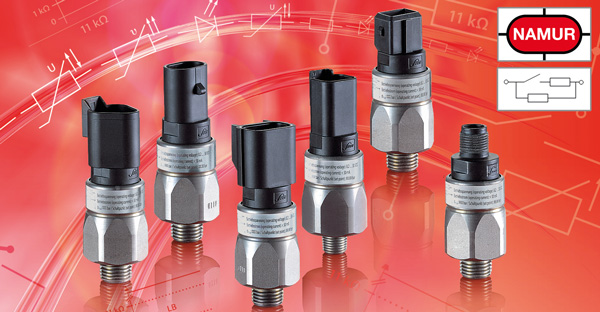NAMUR resistor for safety-relevant applications
The following article describes the technical principles of a NAMUR resistor circuit. In addition to the properties, functions and advantages, application examples are also given.
With the development of SUCO's pressure switches with integrated plugs, the company has established itself as a global supplier of the fluid and hydraulic industry. In addition to the numerous customer-specific plug and thread options, the high IP protection class (IP67 to IP6K9K) is one major advantage over conventional pressure switches.
Under the brand name pressure switches PLUS, SUCO already offers the 2nd generation of integrated pressure switches. The PLUS stands for additional electronic functions that can be integrated as needed to meet the requirements of the customer or application. Additional functions are e.g. a NAMUR diagnostic function, a protective function via varistor, a NTC / PTC thermistor or a LED, stating the switching status.
The resistor circuit according to NAMUR offers an additional diagnostic function ("fail-safe") with short-circuit and cable break detection, which is of special interest for safety-critical systems such as braking systems, hydrostatic steering systems, fire extinguishing systems or automated control valves.
SUCO Pressure switch PLUS NAMUR
According to DIN EN 60947-5-6 (VDE 0660 part 212), NAMUR is a switching contact with two resistors that can act as a normally closed (NC) or normally open (NO) contact. The additional wiring makes it possible to query not only the states ON and OFF, but also a line break (LB) or short circuit (SC) in the circuit. Typical current thresholds according to NAMUR are 1.2 mA for the off state and 2.1 mA for the on state.
SUCO pressure switches PLUS NAMUR are potential-free and are supplied directly via the measuring circuit (operating current IB). The live parts are electrically isolated from the housing, i.e. there is no electrical connection between the switching contact and the housing. Due to the resistor circuitry, a current level is permanently present at the output of the pressure switch, irrespective of whether the contact is activated or not. This is also referred to as the closed current principle.
In the event of a line break or disconnected plug, the circuit is interrupted and leaves the NAMUR range to the bottom. The current is 0 mA with an infinitely high resistance value. If a short circuit occurs on the cable or plug, the current increases significantly above the NAMUR range, since there is only a very small resistor in the circuit.
Using a suitable processing unit, these four current values (ON, OFF, LB, SC) can now be read out as four different switching states. A NAMUR-compliant operation requires an operating voltage of 8.2 ±0.1 VDC. With an open switching contact, a current threshold of 1.2 mA can be realized by a resistor with 11 kΩ. If the switching contact is closed, the resulting resistance is 1 kΩ, which safely exceeds the current threshold of 2.1 mA.
Fail-safe
The special wiring of the SUCO pressure switch PLUS NAMUR enables a so-called fail-safe system to be implemented. As soon as the evaluation unit measures an operating or measuring current of 0 mA at the output, the system switches into the safe OFF state.
According to DIN VDE 0660, Part 209, fail-safe refers to the ability of a system to remain in a safe state or to immediately switch to another safe state in the event of a failure. According to DIN VDE 0660, Part 209, the protected state of the system is reached when a switch-off command is present at the output contact, i.e. the control circuit is interrupted.
Applications
Pressure monitoring devices for safety-relevant applications must work reliable and be approved according to the relevant standards. Mechanical pressure switches are largely installed in safety-relevant industrial applications (e.g. process monitoring, process engineering) and in mobile hydraulic systems that monitor safety-critical functionalities (e.g. hydraulic steering or braking systems).
In both cases a system failure or a malfunction can cause health or financial damage and in the worst case can be life-threatening for the operator of a plant / machine. The need for safe and reliable condition monitoring is therefore a top priority.
Hydrostatic steering / braking system
In agricultural machines such as tractors, a mechanical pressure switch enables the minimum pressure monitoring of a hydrostatic steering system. Only after reaching the safe operating pressure, the pressure switch indicates the good state to the control unit and the tractor is ready to drive.
In order to guarantee a minimum of safety in such an application during regular operation, the closed current principle must be provided and a normally closed contact (NC) must be selected for the pressure switch. The NC contact is closed due to missing or too low pressure, i.e. a current is flowing in the circuit and consequently a signal is present, that prevents the gear from being released.
When the operating pressure is reached, the NC contact is opened and the circuit is thus interrupted. The state "no signal" indicates that the system has sufficient pressure and everything is OK, causing the gear unit to be released. But is it really safe? The control unit cannot detect, if a connection cable is loose, broken or a plug has been removed and therefore constantly reports, that it is ready to drive - a dangerous situation arises.
At this point a pressure switch PLUS NAMUR can showcase its full potential. While conventional pressure switches can only measure and interpret two switching states, the pressure switches PLUS offer two additional state measurements and thus a PLUS of safety. Random errors, manipulations or failures can thus be detected and the machine can be brought into a safe state corresponding to the detected error.
In addition to the safety aspect it is important - especially in agriculture - to offer a 100% operational readiness within a usually short time window, e.g. during harvesting or soil cultivation.
